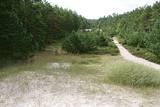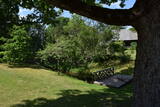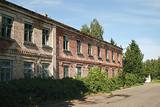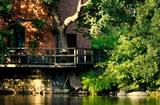| Нo | Название | Описание |
|---|---|---|
|
Семейная ферма Жиляй основана, обслуживается и развивается одной семьей. Любознательные отдыхающие, прогуливаясь, могут увидеть, как выглядят белые павлины, фазаны, утки, куры, лошадки пони, французский скот породы Шароле, белые свиньи генофонда Литвы. |
||
|
Тир – на автостоянке рядом с тем местом, где берет свое начало
природная тропа Колкских сосен, зоркий наблюдатель заметит современную
заросшую широкую просеку, один конец которой заканчивается на морском
побережье, а второй у дороги Колка – Вентспилс. Это место в советское
время использовалось в военных целях – для обучения стрельбе.
|
||
|
Neliela ziepju un dažādu citu ķermeņa kopšanas produktu darbnīca. Pašu audzētos un saimniecības pļavās ievāktos ārstniecības augus iestrādā ziepēs un skrubjos, gatavo no tiem izvilkumus augu eļļās, kurus iekļauj lūpu balzamos un krēmos. Ziepes tiek vārītas tā, kā to darīja agrāk - no sārma un taukvielām. Apmeklētājiem iespēja ielūkoties “Ezervanna” mazajā darbnīcā, paklausīties stāstā par ziepju vārīšanu, iemēģināt roku un radošumu skrubju gatavošanā vai “pamīcīties” ar ziepju veidojamo masu un pagatavot savu ziepju gabalu. |
||
|
The farm "Kronīši" is located in Viļķenes Parish, Limbažu County. The farm grows organic vegetables that are processed into various home preserves. Teas are produced from plants collected from organic meadows, jams, preserves, syrups and juices are also on offer. Fruits and berries are collected from the garden itself, as well as from local farmers and the nearby Rūstuži and Blome marshes. The farm welcomes tourists and exchange groups with prior application. For family events, incl. a teahouse is available for children's parties, creative workshops and other activities. Offers tours with Soviet-era cars and retro cars. |
||
|
Found at Rīgas Street 22A, this impressive building was suggested by Latvian President Kārlis Ulmanis and built in 1936 and 1937 after a design by the architect Verners Vitands. It is seen as one of the most outstanding architectural monuments from the first period of Latvian independence, and it is said that it was once the most modern multifunctional building in all of Europe. The building now houses the Daugavpils Theatre, the Latgale Central Library, the Latvian Cultural Centre, the Latvian House, the US Information Centre, the Daugavpils Tourism Information Centre and other institutions. Unity Square is alongside the building, and beautiful compositions of flowers are nearby during the growing season. |
||
|
The memorial site with a 1936 monument produced by the sculptor Kārlis Zāle is located in Smārde near the Smārde-Tukums road. It commemorates 38 soldiers who fell during World War I. Between 1915 and 1917, the front line was near Smārde. Many men were killed, and they were buried at the local swamp. It was only after the war that they were reburied in Smārde, Kūdra, Ķemeri, and Sloka. |
||
|
Bārbeles sēravots tiek dēvēts par vienu no pirmajām kūrvietām Latvijā, proti, jau ap 1650. gadu hercoga Jēkaba valdīšanas laikā sēravota tuvumā uzbūvēta vannu māja, dēvēta par mazo ūdensdziednīcu, kuru vēlāk arī apmeklējuši visi Kurzemes-Zemgales hercogi. 1739. gadā Rīgas garnizona ārsts Benjamins Teofils Grofs uz Bārbeles sēravotu nosūtījs 10 ievainotus un smagi slimus karavīrus, kas sirguši ar dažādām kaitēm - pēc Bārbeles sēravota vannām karavīri atveseļojušies. Avota ūdeni izmantojuši gan apkārtējie zemnieki, gan muižnieki, gan augstmaņi no Jelgavas. Avotā slimnieki peldējušies, aptriepušies ar dūņām, no tā sagatavotas arī siltās vannas. Tāpat ūdens tika izmantots iekšķīgai lietošanai. Bārbeles sēravots dziedinājis ne tikai skorbutu, locītavu un krustu sāpes, artrītu, pietūkumu, bet arī venēriskās slimības-sifilisu, nervu kaites un daudzas citas slimības. 19. gs. avota ūdenī samazinājās sērūdeņraža koncentrācija. Neskatoties uz to, 20. gs. 20. gados šeit vēl aizvien darbojās vannu māja, tika uzbūvēts arī neliels vasarnīcu rajons, ierīkots deju laukums un parks, kūrorts tolaik tika plaši apmeklēts. Diemžēl, kūrorta noriets seko pēc Otrā Pasaules kara, kad to noposta un vairs neatjauno. Šobrīd par savulaik tik ļoti apmeklēto un nozīmīgo kūrvietu, dēvētu par pirmo kūrortu Latvijā, var tikai iztēloties. Atrodoties pie sēravota, tā laika liecības iezīmējas pēdējās vannu mājas ēkas pamatu drupās, stalti liecinieki arī koki – glabājot sevī savulaik pieredzēto. Sēravota apkārtnē ierīkota atpūtas vieta, informatīvs stends, kurā var aplūkot senākas fotogrāfijas un detalizētāk iepazīties ar kūrorta vēsturi. Tāpat ierīkota laipa, no kuras apmeklētāji var pasmelt avota ūdeni. |
||
|
Здание бывшей Морской школы – образование в Морской школе (1894 – 1914
гг.) получили более 1000 студентов. В советское время здесь размещался пункт пог-
ранохраны Советской армии. Сохранилась пограничная вышка. По дороге к морской
школе видны лесистые приморские дюны с небольшими строениями, создающими
интересный прибрежный пейзаж. Дорогу, соединяющую Морскую школу с морем,
когда-то называли Аллеей капитанов или Дорогой капитанов.
|
||
|
Маяк Кыпу старейший постоянно действующий маяк в мире и располагается на самой высокой точке Западной Эстонии- горе Торнимяги (68 м.). На маяке есть выставка, у его подножия располагается кафе. |
||
|
This restricted area is on the eastern shore of Lake Ķīšezers, and of the greatest importance here are the habitats – flood-land and other meadows, dunes, the aquatorium of Lake Ķīšezers, the shoreline, forests of oak, black alder and other trees, and many huge oak trees in the restricted area and beyond its borders. The Bulduri castle hill, which is the most distinct ancient castle hill in Rīga, is on the southern end of the Lieupsala peninsula. On the border of the restricted area is an affiliate of the Latvian Open-Air Ethnographic Museum, which is known as “Vārnas”.
|
||
|
На полях крестьянсого хозяйства пасется более чем полторы сотни овец. Построена станция для кормления баранов, организуются аукционы животных и Дни овец. Хозяин проводит экскурсии, предлагает приобрести племенных овец и продукцию овцеводства. |
||
|
В мастерской можно приобрести керамические изделия, понаблюдать за гончаром в работе, а также принять участие в процессе обработки глины. Приглашает на открытие печи. |
||
|
This tour includes a walk along the Baltic Sea coast Lithuania through the Curonian Spit from Nida to Smiltynė (see a detailed description under tour No. 9) and continues further north from Klaipėda to Šventoji located at the Lithuanian/Latvian border. Klaipėda and Palanga are popular seaside resorts with lots of pubs, hotels, street cafés and musicians. Klaipėda is the only port city and the third largest city in Lithuania. Šventoji is also a popular seaside town located next to the mouth of the river Šventoji. Between Klaipėda and Palanga, the Baltic Coastal Hiking Route leads through the Seaside Regional Park (Lithuanian: Pajūrio regioninis parkas). It was founded for the protection of coastal and marine landscapes, biodiversity and local cultural heritage. The most famous place of the seaside is the Dutch Hat (also called Dutch Cap, Dutchman’s Cap or Holland’s Cap) – a 20 m high cliff, which used to serve as a landmark and guide for seafarers and fishermen. |
||
|
Единственное место в Латвии, где с конца 19-го века проводят полный технологический процесс переработки шерсти. Мастерская по пошиву шерстяных одеял и подушек в Дундаге. |
||
|
Находится в начале главной улицы Кулдиги для пешеходов и велосипедистов - улицы Лиепаяс. Размещен в архитектурно интересном двухэтажном деревянном здании, где когда-то был амбар. Латышская кухня: Крестьянский завтрак, овсяная каша, холодный суп на кефире, суп из щавеля, огурцов и фасоли, говядина в луковом соусе, охотничьи колбаски, картофельные блины, сладкие блинчики с брусничным соусом. |
||
|
Маршрут проходит по прекрасным цветочным садам Курземе и Жемайтии. В Кандаве находится самая большая коллекция ирисов. «Миеркални» является крупнейшим садом лилейника в Восточной Европе с более чем 1000 его сортами. Владелец производит также фруктовые и ягодные вина. В природном парке Талсинской возвышенности находятся яблоневые сады Курземниеков, где можно приобрести фрукты или продукты из них (сушеные яблоки, яблочные чипсы, соки). В хозяйстве окружающей среды и здоровья «Упмали» готовят чай, смеси из трав, растительные масла, особые бальзамы, косметику, травяное мыло и т. д. - под маркой Анна Берманс. В Саулескалнском дендрарии находится самая старая в Латвии 50-летняя магнолия. Более 100 сортов пионов выращивают в саду Зиедоню. Владельцы усадьбы Марас предлагают исторические рассказы немецких усадеб района Кулдиги. В молочной усадьбе Бергхоф находится Музей молока. В дендрологическом саду Мара Линде можно найти экзотические сорта цветов и деревьев. В фермерском хозяйстве «Турайдас» производит травяные чаи и чайные мешочки для сувениров или подарков, используя малину, пижму, манжетку, подорожник и цветы липы. В поселке Ница путешественники могут посетить несколько декоративных садов, которые поддерживают местные традиции садоводства. В Руцавском дендрарии можно осмотреть коллекцию магнолий. Самый большой японский сад в Европе (16 га) - это место для коллекции традиционных ароматических растений и овощных культур. Усадьба в Паланге, где расположен Музей янтаря и парк Бирутес является одним из наиболее хорошо сохранившихся усадебных комплексов в Литве. Кретингский усадебный парк - один из старейших усадебных парков 16-18 в. в Литве. В ботаническом саду Клайпедского университета расположен прибрежный этнографический сад с типичными для этой местности сортами цветов. Клайпеда - самый популярный приморский курортный город в Литве. Морской музей и дельфинарий являются одной из самых известных туристических достопримечательностей Клайпеды. В усадьбе Шилуте есть два парка - английский ландшафтный парк с прогулочными дорожками и лесопарк, известный как Варнамишкис или так называемый «Вороний лес». Пакалне - это уникальный традиционный рыбацкий двор с садовыми растениями, характерными для этого региона Литвы. |
||
|
Svartå Manor is one of the most precious manor houses in Finland with a history of more than two hundred years. The countryside hotel consists of five different historical buildings situated in an idyllic park with a scenic river flowing nearby. Near the manor is a restaurant and a museum, where you can take a tour. |
||
|
Saimnieks Valentīns Kuklis savā viensētā izveidojis no koka un citiem materiāliem un vēsturiskiem priekšmetiem veidotu brīvdabas kolekciju, kas savākta g.k. no Latgales lauku sētām. Daļa no vēsturiskajiem priekšmetiem ir izvietota saimnieka veidotā muzejā. Piedāvā ekskursiju un stāstījumu par savāktajiem darbarīkiem un sadzīves priekšmetiem. |
||
|
Dabas taka atrodas Zaķumuižā un ved cauri vecajam muižas parkam, pa ceļam iespējams aplūkot simtgadīgus kokus, dažādus augus, kā arī dažādus kukaiņus, putnus. Taka ir veidota kā mācību taka un to veidojusi Zaķumuižas pamatskolas skolotāja. Taka ir 1,5 km gara. Tai ir vidējas grūtības pakāpe: takas reljefs ir samērā vienmērīgs, mērens, izņemot atsevišķus posmus (daži stāvumi un kritumi, dažviet nelīdzens reljefs), tāpēc īpaša fiziska sagatavotība pirms takas iziešanas nav nepieciešama. Vietās, kur reljefs ir stāvāks, izvietoti roku balsti, bet pāri muižas dīķu sistēmas ūdeņiem uzcelti divi tiltiņi.
|
||
|
Atrodas Taurenē, Gaujas labajā krastā. Muižas apbūve, kurā ietilpst pils (19. gs. 80. gadi, arhitekts – R. G. Šmēlings, historisma un neoklasicisma stils), senie alus pagrabi, klēts, vecā pils un parks, veidojies 19. - 20. gs. Šobrīd muižas pilī atrodas Taurenes pagasta pārvalde un kultūras nams. Muižas kompleksā ietilpst ēka, kurā atrodas Vecpiebalgas novada tūrisma informācijas punkts un Taurenes novadpētniecības ekspozīcija (senajā ledus pagrabā). Parkā (ziemeļos no pils) uzmeklējams piemiņas akmens, kas veltīts komunistiskā terora upuriem. Pie Nēķena muižas sākās 0,4 km garā Cieres dabas taka, kas iepazīstina ar Gaujas krastu mitrājiem. |
||


























